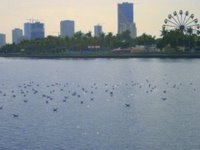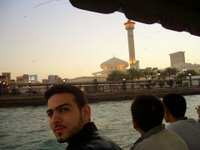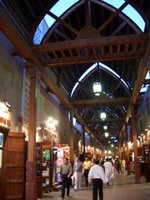A Little Bit of Sightseeing
Not quite a shower
The dry, dusty desert immediately outside the University City confines can really deceive the unsuspecting traveler. Few would suspect that beyond the several roundabouts and flyovers lay a lush, shady oasis of a city that was Sharjah.
It was Yaroob’s idea that we go for a bite at Hadramoot, a Yemeni restaurant about ten minutes away from the University—and what a bite it was. Once there, he ordered for a tray of mandi, a Yemeni dish consisting of yellow rice, fresh, succulent herbs, a rich sauce and skewered chicken so tender they simply fall apart at the slightest touch of your fingers. The dish may have been foreign to us, but hunger was a universal feeling—within minutes, new bowls of sauce and plates of herbs were brought to replenish the depleted items.
It is commonly joked that mandi is so sumptuous a meal, it renders you immobile for a few hours afterwards. Seeing how true it was, at least in our case, it was no wonder that the dish was thought best served and enjoyed on the floor with plenty of space to stretch your legs and laze about afterwards.
The cup of traditional tea served as well as the bottle of ataar at the cashier counter caught my eye on our way out. In a way, they added another sense of cultural finesse to the dining experience that was mandi.
Sharjah: heritage city of the east
Now that the sun had shifted to a more tolerable position, it was more comfortable then to enjoy the attractions of this coastal city.
The Buhaira, a lagoon surrounded by high rise buildings and green parks was a captivating sight.
 Hundreds of seagulls ubiquitous to the city glided effortlessly above us, heading for the rich pickings the sea has to offer, while hundreds more were already floating on the water surface, along with the dhows and boats that occasionally passed by.
Hundreds of seagulls ubiquitous to the city glided effortlessly above us, heading for the rich pickings the sea has to offer, while hundreds more were already floating on the water surface, along with the dhows and boats that occasionally passed by. Everything about the place was a mixture of the old world and the new—on the side of the wharf was an ancient building made of mud bricks, defiant towards the shiny glass-and-steel commercial towers constituting the city’s fast growing skyline. Elsewhere, stone structures—historic remnants of the old kingdom—stood at the center of several roundabouts like dignified elders among the new generation.
 The cool salty breeze was especially refreshing and evidently appreciated by the citizens. Families had picnics on the grass by the Buhaira while youths played games on the footpaths, and joggers and walkers made their way around as we went on with our relaxing tour. It was also hard to miss the two Ferris wheels located at strategic locations by the lagoon, adding a whimsical touch that was strangely romantic at the same time. Young families could be seen having a good time together aboard the wheel, while other families chatted over tea and coffee at the sidewalk cafés in the evening sun—romantic indeed.
The cool salty breeze was especially refreshing and evidently appreciated by the citizens. Families had picnics on the grass by the Buhaira while youths played games on the footpaths, and joggers and walkers made their way around as we went on with our relaxing tour. It was also hard to miss the two Ferris wheels located at strategic locations by the lagoon, adding a whimsical touch that was strangely romantic at the same time. Young families could be seen having a good time together aboard the wheel, while other families chatted over tea and coffee at the sidewalk cafés in the evening sun—romantic indeed.Dubai: the city of money
Our first ‘real’ visit to Dubai took place about a week later, again courtesy of our Iraqi friend and his trusted VW. The infamous first trip which comprised only the Dubai City Center somehow gave us an unpleasant first impression of the city—this time however, Dubai had certainly redeemed itself by proving its reputation as a remarkable fusion point of heritage, progressiveness and globalization.
It was much later in the evening when we started out, around an hour before maghrib (sunset). After parking at Baniyas Square, named after the largest tribe to originally settle in the Emirates,
 we set off by foot towards the scenic heart of the city, Dubai Creek or Khor Dubai as it was locally known. Passenger-carrying boats called abras ferried back and forth across the wide Khor, and we wasted no time and boarded one for several fils per person. The humid, musty smell of damp wood and freshwater was reminiscent of the Nile cruise from my 1998 visit to Cairo.
we set off by foot towards the scenic heart of the city, Dubai Creek or Khor Dubai as it was locally known. Passenger-carrying boats called abras ferried back and forth across the wide Khor, and we wasted no time and boarded one for several fils per person. The humid, musty smell of damp wood and freshwater was reminiscent of the Nile cruise from my 1998 visit to Cairo.While glassy towers bearing the names of commercial giants stood overlooking the Khor along the bank we departed from, traditional windtowers and minarets awaited us on the other. We were headed for Deira, the public market of old Dubai where we could catch a glimpse of souq life in this otherwise cosmopolitan city.
 A strong aroma of spices, herbs, and incense greeted us as we entered the narrow alleys between the old shops and stalls. Traders heartily beckoned passersby for a glimpse at their wares, and buyers haggled for good deals. The old souq with its rich selection was definitely the place for the tasteful shopper.
A strong aroma of spices, herbs, and incense greeted us as we entered the narrow alleys between the old shops and stalls. Traders heartily beckoned passersby for a glimpse at their wares, and buyers haggled for good deals. The old souq with its rich selection was definitely the place for the tasteful shopper. The setting sun immediately triggered a chain of maghrib prayer calls from the numerous mosques situated on both sides of the Khor. Interestingly, it was also the first time I ever heard a Shiite azan with a testimony to Ali yun waliyullah called out after the testimony to Muhammad as Rasulullah. The azan came from a mosque several minutes later than its Sunni counterparts. This encounter provided a useful insight on the Sunni-Shiite coexistence, which I learned was limited to only a few Gulf countries, with UAE and Bahrain considered excellent examples.
Regardless, having heard the calls to prayer, it would not do to ignore maghrib in favor of greedy sightseeing and photography. It was getting a little too dark anyway—and classes awaited us the next day—thus it was decided to call it an evening.

